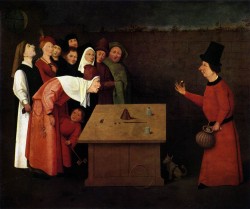
Hamburger 1984
“Bosch’s Conjuror : an attack on magic and sacramental heresy” (Jeffrey Hamburger) 1984
[in: Simiolus, vol. 14 (1984), nr. 1, pp. 4-23]
In this article Jeffrey Hamburger (teaching at Yale University in New Haven) focuses on the iconography of Bosch’s Conjuror panel (Saint-Germain-en-Laye, Musée Municipal). First he correctly signals that the lack of information about the original context, commissioner and function of this panel does not simplify the iconographer’s task. According to the author this problem can be solved by looking for similar contexts within Bosch’s oeuvre. Hamburger spots an iconographical similarity between The Conjuror and a detail in the central panel of the St. Anthony triptych (Lisbon) where some sort of anti-mass is being celebrated, a motif that fits in well with the theme of the central panel which opposes true to false religion. (According to Hamburger the officiant of this mass is the person with the pig’s head – an observation which is highly doubtful.) The Conjuror can also be interpreted as an anti-mass during which the conjuror lures the naive spectators away from the true belief in Christ by means of his false miracles.
The conjuror is in fact a discreditable magician. Because of his tricks the woman who is stooping forward in front of him, is vomiting a frog. In the middle ages the frog’s symbolism was closely related to the toad’s and both animals were associated with evil, with the devil and with heresy. When he painted this motif Bosch was inspired by Revelations 16: 13 where the false prophet (the dragon, the beast) is said to vomit frogs. Hamburger’s argument then takes a weird turn: although the frog is being vomited by the woman, she is not the diabolical false prophet, but the conjuror who betrays his true nature by performing a diabolical miracle. The fact that there is also a thief in Bosch’s panel refers to Revelations 16: 15 (where Christ says that He will show up at the Last Judgment as a thief, meaning: unexpectedly). ‘Using a well-known biblical text, Bosch places mundane foolishness within a context of universal retribution’ [p. 11].
Yet, The Conjuror is not about the Apocalypse or about damnation but about mundane foolishness, more precisely about a special form of mundane foolishness, namely the belief in heresy. Bosch is warning of anti-sacramental heresy: heresy which doubts the dogma of transsubstantiation. Although in The Conjuror Bosch did not depict a mass, in the middle ages magical and heretical practices were closely interwoven. The conjuror is holding an object between his thumb and index (whereas the other fingers are stretched): this is the same manual gesture with which the priest presents the host during consecration. In this way Bosch wanted to oppose the conjuror’s false magic to the true magic of the Eucharist. The conjuror is a diabolical accomplice of the Antichrist and tries to lure people away from Christ with his treacherous tricks.
According to Hamburg other details of the painting fit in with this interpretation. The conjuror has a hooked nose (which refers to the jews but especially to moral crookedness), the owl in the little basket at his side refers to foolishness and spiritual blindness, the child with the whirligig is a symbol of the spectators’ folly and the crane on the wall is a symbol of alertness: it raises its head to cry out man’s foolishness but nobody pays attention.
Hamburger concludes: The Conjuror is not only a satirical attack on folly and credulity, but also on the stupid belief in heretical practices. The conjuror himself is an accomplice of the Antichrist and performs a parody on an important ritual of the catholic Church. In The Conjuror Bosch adapts and mixes traditional metaphors in such a way that his public could easily understand his message. This observation should be the basis for interpreting other, more complex works by Bosch.
It is remarkable that Hamburger suggests a religious interpretation for a Bosch panel which is generally considered to be profane, but his arguments are not wholly convincing. The conjuror’s manual gesture is not really similar to the manual gesture of priests who present the host in medieval illustrations (the conjuror’s fingers are nót stretched) and the link between the frog which is being vomited and Revelations 16: 13 is rather loose (it should be the conjuror who is vomiting a frog). Further research has to clarify whether the vomiting of a frog cannot be interpreted in another way within the context of this painting. It is also interesting to find out whether the opposition of false, heretical magic and the ‘orthodox magic’ of Christ (a motif that does exist in the late middle ages) is indeed relevant in Bosch’s The Conjuror.
[explicit]